Are Most Animal-like Protists Heterotrophs Or Autotrophs?
Autotrophs and heterotrophs – What are the deviation?
Autotrophs and heterotrophs are ii nutritional groups found in ecosystems. The main divergence betwixt autotrophs and heterotrophs is that autotrophs can produce their ain food whereas heterotrophs eat other organisms as nutrient.
| Autotrophs | Heterotrophs |
| "Self-feeders" – produce their own nutrient | "Other eaters" – do not produce their own food |
| Make nutrient from inorganic materials | Go nutrient by eating other organisms |
| Producers | Consumers |
| At the primary level in a food concatenation | At the secondary and tertiary levels in a food chain |
| Are either photoautotrophs or chemoautotrophs | Are either herbivores, carnivores, omnivores, or detritivores |
| Plants, algae, some bacteria, and archaea | Animals, fungi, some bacteria, protists, and parasitic plants |
What is an Autotroph?
Autotrophs are organisms that are capable of producing their own nutrients using inorganic substances. What autotrophs need could be but the sunlight, water, carbon dioxide, or other chemicals. In contrast, heterotrophs are organisms that cannot produce their own nutrients and crave the consumption of other organisms to live.
Autotrophs are the essential foundation of any ecosystem. They produce nutrients that are necessary for all other types of life on the planet. Because autotrophs produce their own food, they are also referred to as producers in nutrient chains.
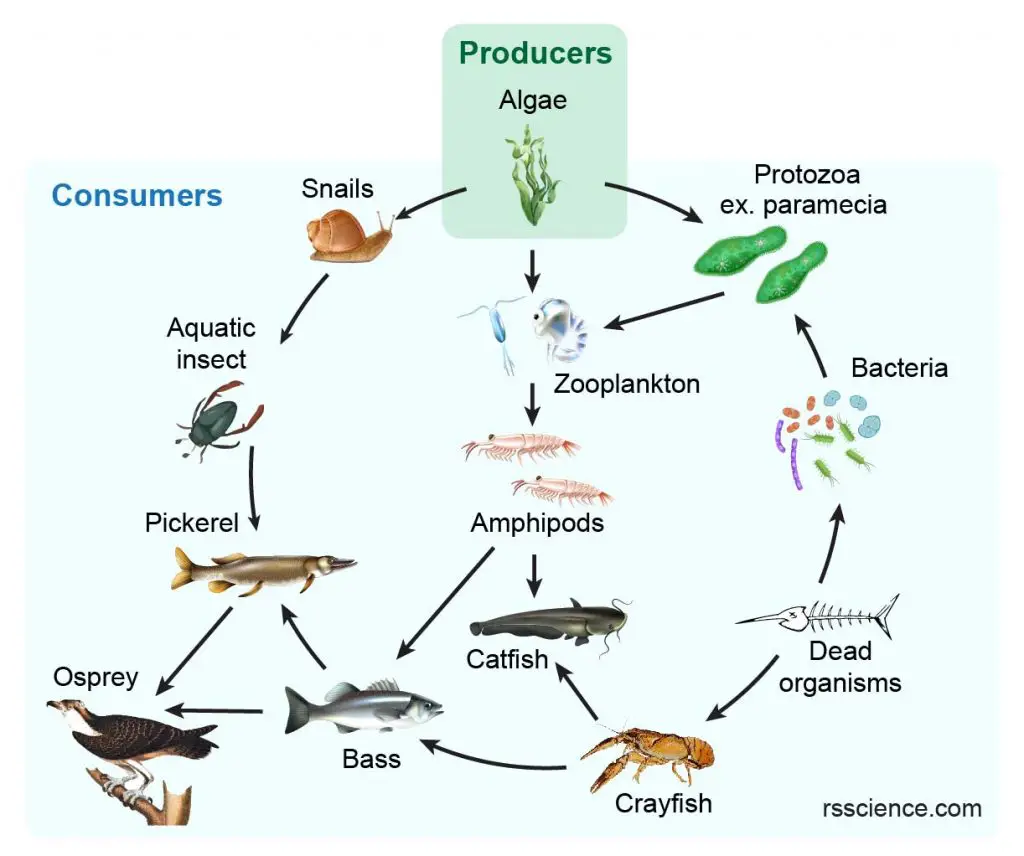
[In this image] In this pond ecosystem, algae as autotrophs are the producers that sustain all other heterotroph organisms. An increment in the number of autotrophs could supply the growth of heterotrophs, whereas the decrease in autotrophs results in starvation and a reduction in the number of other organisms also.
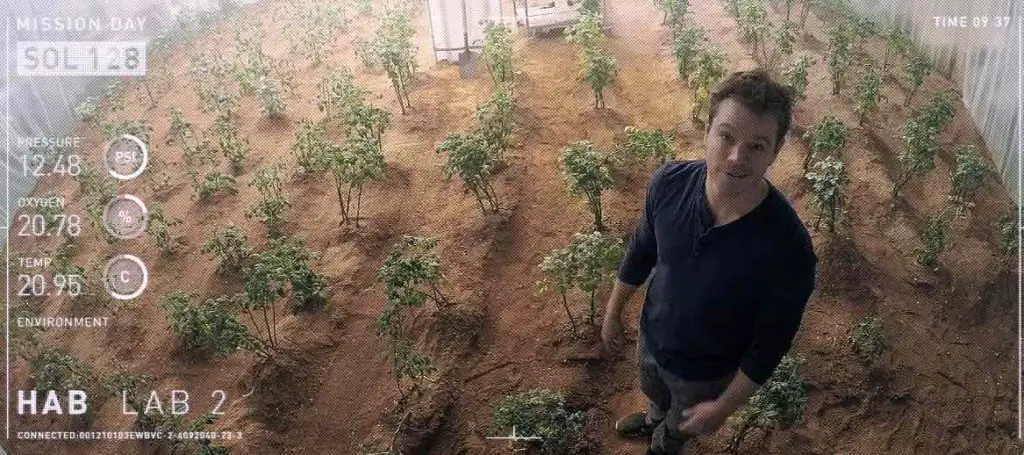
[In this image] Have you seen the picture show "The Martian" by Matt Damon in 2015? He planted a minor subcontract of potatoes in order to survive on Mars. You can say that the tater plants are the producers for that extremely isolated ecosystem, and Matt is the consumer. Watch the motion picture here https://world wide web.youtube.com/watch?v=TeZDLAaDYos
The name "autotroph" came from 2 words – "car" ways self and "-troph" means food, indicating that these organisms tin can produce their own nutrient. The term "autotrophy" is often used to refer to the living strategy of autotroph organisms.
How does an Autotroph produce its own food?
Depending on the blazon of autotrophs, they either obtain the source of energy from sunlight or from chemical reactions.
Photoautotrophs
Plants are the most common types of autotrophs, and they use photosynthesis to convert solar energy to the nutrients that biological cells tin utilise. This ktype of autotrophs is called photoautotrophs.
Plants have specialized organelles within their cells, called chloroplasts, which manage the process of photosynthesis. A grouping of paint molecules called chlorophyll is responsible for the energy conversion in chloroplasts.
Learn more about chloroplasts by clicking the image below.
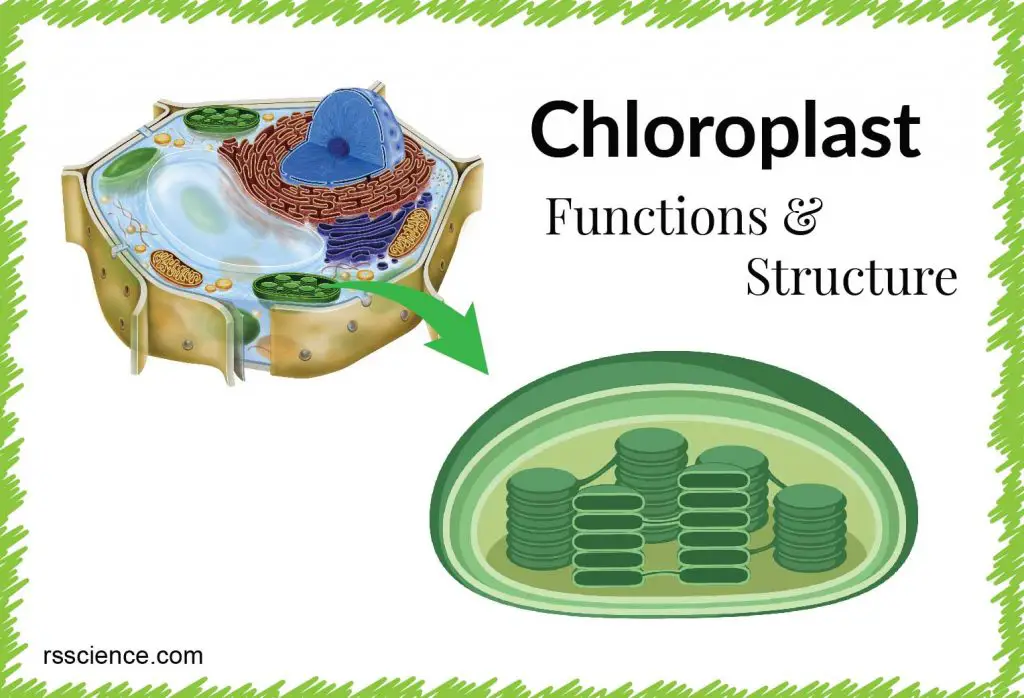
In combination with water and carbon dioxide, chloroplasts produce glucose, a simple sugar used for energy, besides equally oxygen as a byproduct. Glucose provides diet for the plant cells. Glucose can also exist transformed into other forms, such every bit starch that are stored for later usage or cellulose that is used to build the cell walls. Heterotrophs consume these plants to acquire this organic nutrition.
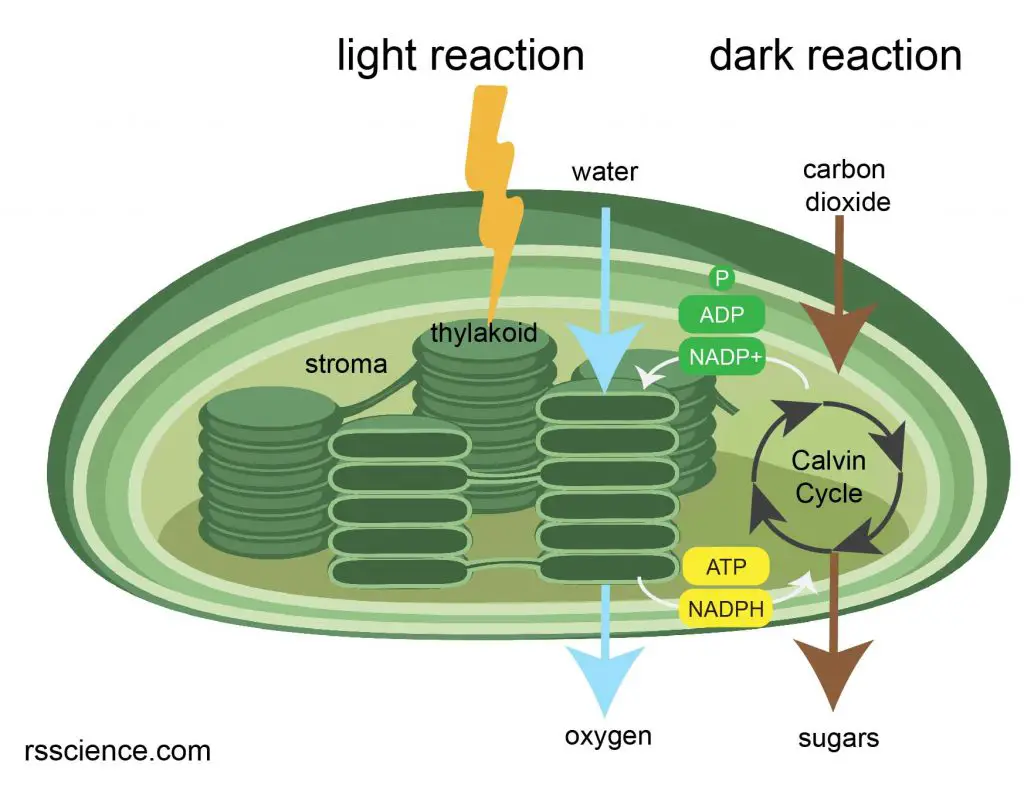
[In this image] Illustration of photosynthesis.
Chlorophylls in the chloroplasts blot the solar energy and transfer the energy to ATP and NADPH. In the dark reaction, the enzymes and proteins in the chloroplasts use these high energy molecules to catechumen carbon dioxide to sugars.
Other examples of photoautotrophs include algae, phytoplankton, and some types of leaner. However, some of them don't have chloroplasts and may utilise other photosynthetic pigments to blot sunlight. Meet later for these examples.
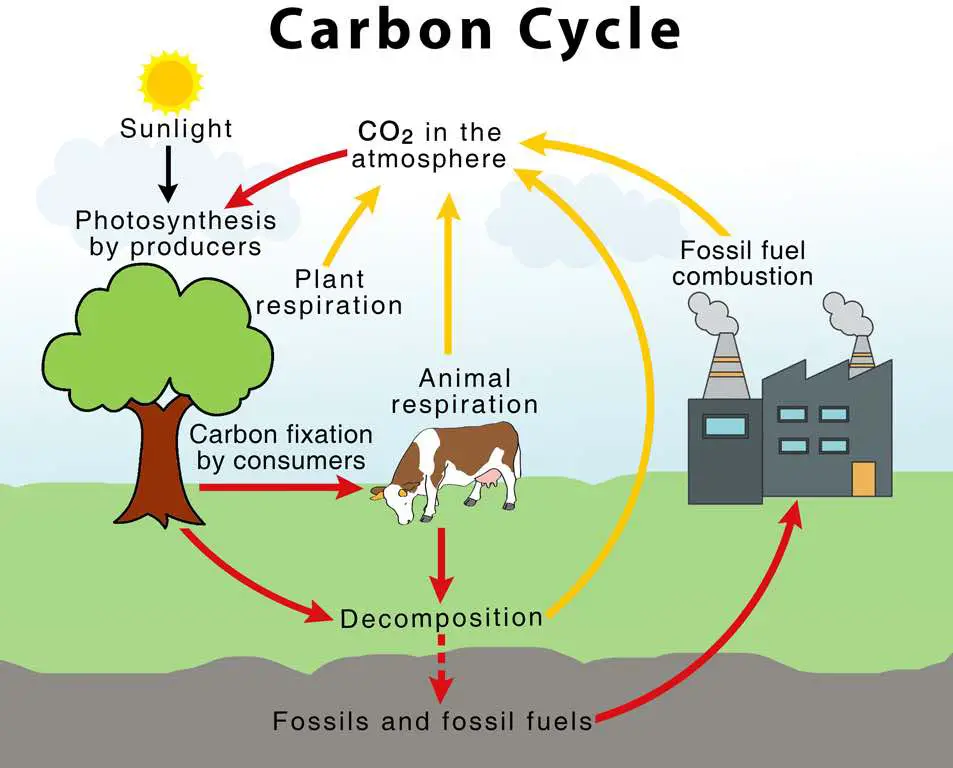
[In this paradigm] Carbon Bike.
Photoautotrophs are of import in the carbon cycle equally they utilize carbon dioxide released by heterotrophs during respiration to renew the energy source.
Photo credit: Sciencefacts.cyberspace
Chemoautotrophs
Some bacteria and archaea can utilize energy obtained from an oxidative chemical reaction (chemosynthesis). These chemoautotrophs differ from photoautotrophs in that they do not depend on sunlight for energy. Instead, chemoautotrophs use chemicals such as methane or hydrogen sulfide forth with oxygen to produce carbon dioxide and free energy. Every bit a event, these chemoautotrophs are oftentimes found in extreme environments, similar deep-bounding main vents, hot springs, and deep trenches.
Scientists believe that some chemoautotrophic archaea are closest to the earliest life forms on Earth. Chemoautotrophs are also studied for their role in astrobiology considering of their ability to survive in extreme weather condition.
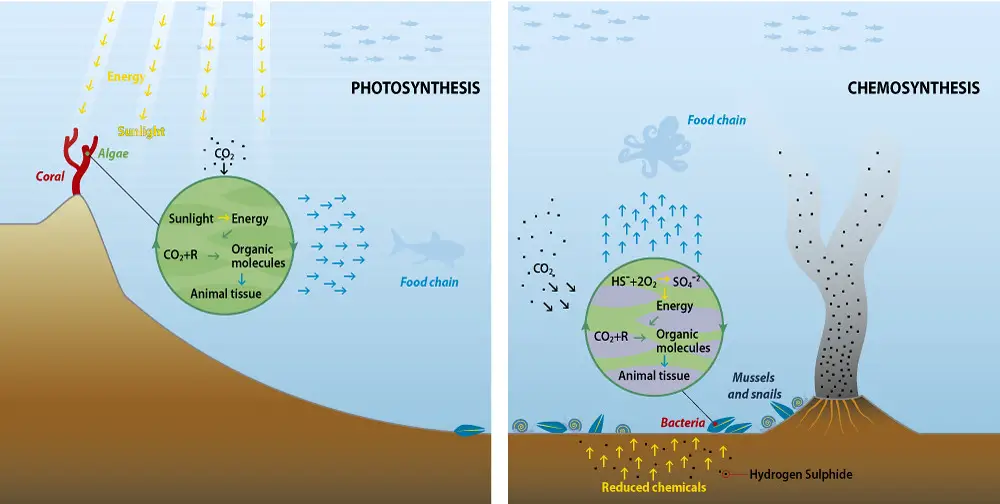
[In this image] A comparison between the marine habitations suitable for photosynthesis and chemosynthesis.
Photograph credit: Grid
Examples of Autotrophs
Green plants
Light-green plants are the most well-known group of autotrophs. Using water from the soil, carbon dioxide from the air and calorie-free from the Sunday, green plants perform photosynthesis to provide their own nutrients (so they are photoautotrophs). Green plants are found in most ecosystems where they are the primary producers of food and energy for all other living organisms.
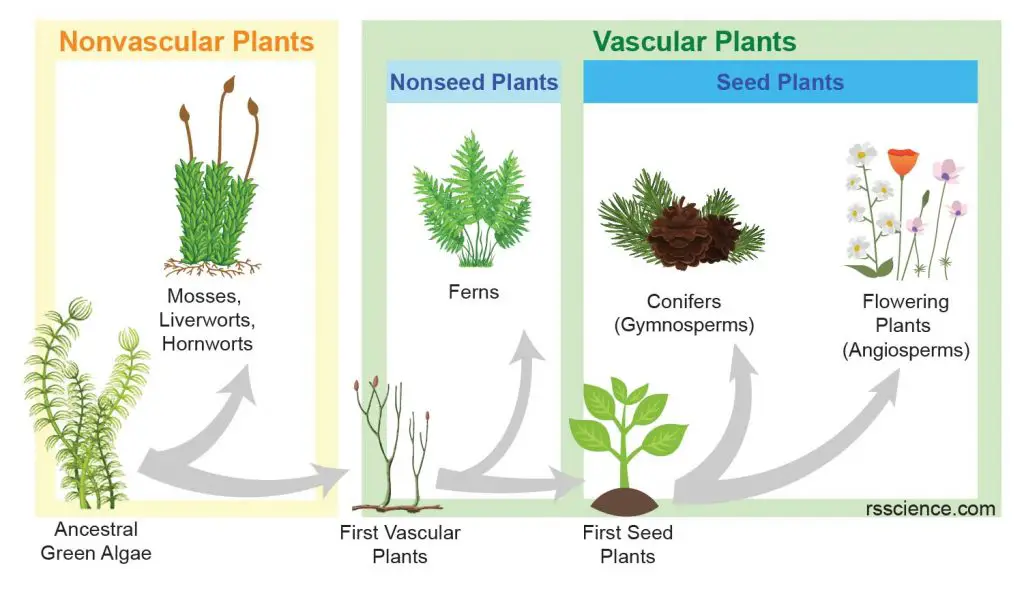
[In this image] Plants (the kingdom of Plantae), including liverworts, hornworts, mosses, ferns, conifers, and flowering plants, all alive equally photoautotrophs.
Algae
Algae (singular, alga) are a general term for a various group of eukaryotic organisms that are capable of photosynthesis. Algae include unicellular microalgae, such as the diatoms and chlorella, and multicellular algae, such as seaweeds that may accomplish 60 m in length and form underwater kelp forests.
Algae have chloroplasts, simply their chloroplasts are different from the ones in land plants in terms of the number of chloroplasts in a cell, the shape of chloroplast, and the type of chlorophylls in chloroplasts. For example, volvox cells accept simply ane giant, horseshoe-shaped chloroplast per cell.
Learn more than most volvox past clicking the paradigm below.
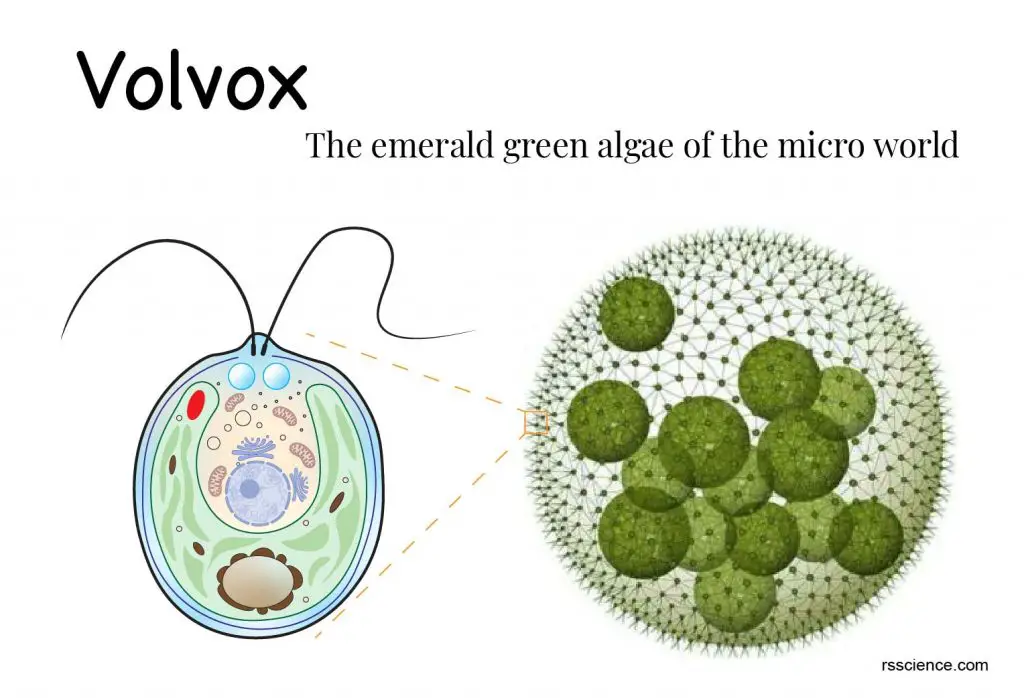
Greenish algae use chlorophylls primarily for photosynthesis.Red algae have chlorophylls but as well accept arable amounts of phycobilins (a group of red pigments that besides blot sunlight) in their chloroplasts, giving red algae their distinctive color.
Learn more about greenish algae and red algae by clicking the images below.

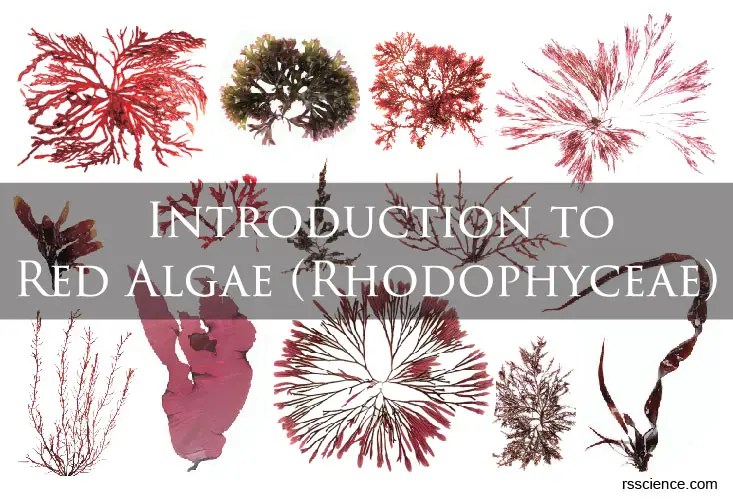
Cyanobacteria
Cyanobacteria, also known every bit "bluish-green algae," are a grouping of gratis-living photosynthetic leaner. Cyanobacteria are autotrophic and tin can obtain their energy through photosynthesis. Since cyanobacteria are prokaryotic cells, so of course, they practice not have chloroplasts. Their chlorophyll molecules are in the cytosol.
Scientists believe that cyanobacteria played a significant role in World'southward history by producing the largest source of Otwo in the atmosphere today. However, an overgrowth of cyanobacteria chosen cyanobacteria flower is harmful.
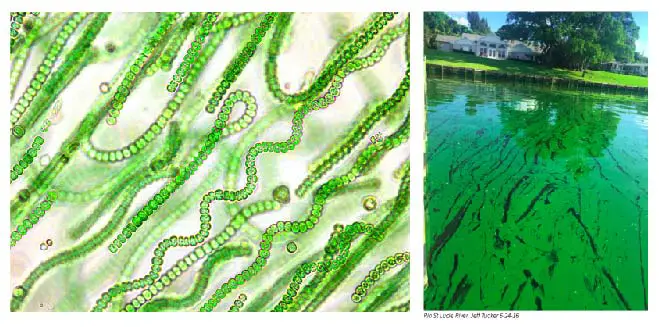
[In this figure] Left: Microscopic images of Blue-green alga, showing many single cells assembled into long chains. Right: A motion-picture show of the cyanobacteria bloom.
Photograph source: cyanobacteria, Beachapedia
Phytoplankton
Planktons are microorganisms that drift about in the h2o. Some planktons that brandish a plant-similar behavior (pregnant, can alive by photosynthesis) are called phytoplankton. Phytoplankton tin can be divided into two classes – microalgae and cyanobacteria. Most freshwater phytoplankton are green algae and blue-green alga. Marine phytoplankton are mainly comprised of microalgae known every bit dinoflagellates and diatoms.
Larn more than most swimming life microorganisms by clicking the images beneath.
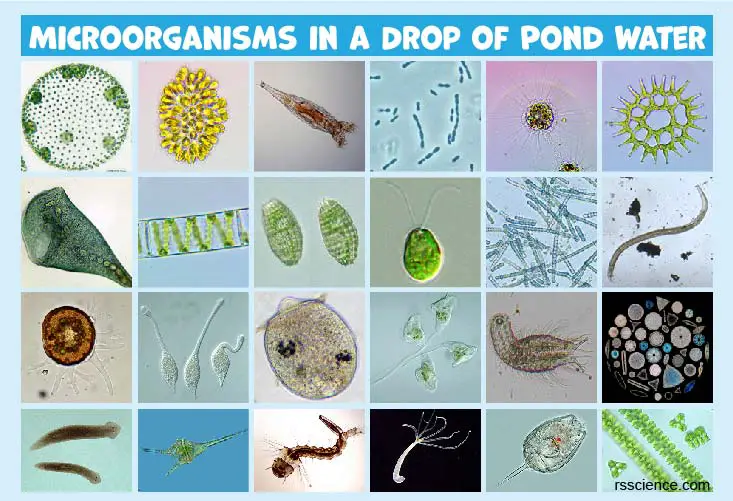
Bacteria and archaea
Both leaner and archaea are prokaryotic cells. Some of them tin alive by chemosynthesis in farthermost environments.
For instance, some bacteria near hydrothermal vents in the deep ocean can produce food using hydrogen sulfide. Hydrothermal vents are like geysers or hot springs on the ocean floor. Hydrothermal vents are unremarkably found near volcanically active places, where seawater seeps down through a narrow scissure into hot, partly melted rock below.
The boiling-hot water then circulates support into the ocean, loaded with minerals from the hot rock. These minerals, including hydrogen sulfide, are toxic to most organisms just could exist used by certain leaner to flourish.

[In this image] Hydrothermal vents form at locations where seawater meets magma.
Photograph credit: National Ocean Service
These abyssal vents could course unique ecosystems that don't rely on solar energy at all. For case, scientists plant colorless, ghost-like octopuses, tubeworms, sea stars, and yeti crabs feeding on bacteria that live off minerals spewed from the hydrothermal vents.
[In this video] Yeti crab (white) piles effectually the hydrothermal vents in Antarctica. These yeti crabs seem to cultivate "gardens" of leaner on their chests, which are covered with hairy tendrils.
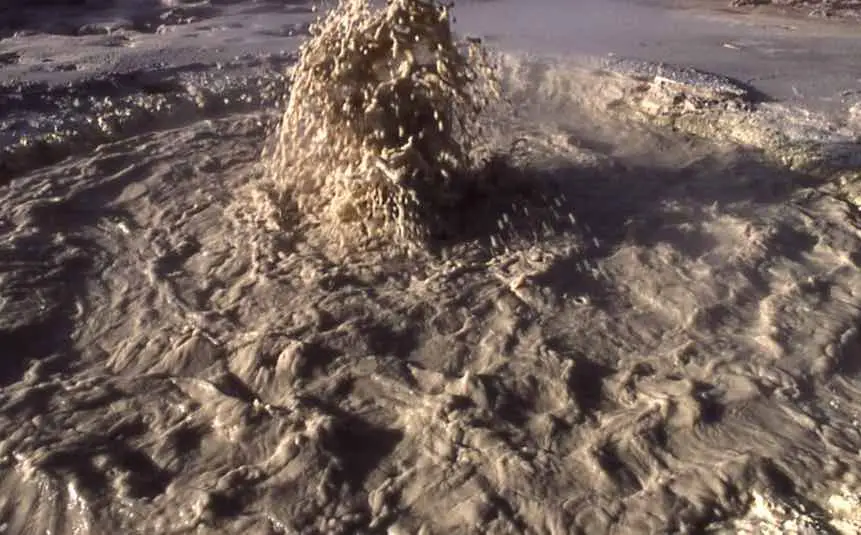
[In this paradigm] Thermophilic archaea alive in the mud volcanos of Yellowstone National Park.
Thermophilic archaea convert sulfur into sulfuric acrid, which helps dissolve the rocks into mud. Past living in such a superhot, acidic environment, they are the nearly extreme of all extremophiles on Earth.
Photo credit: National Park Service
Chemoautotroph bacteria tin can too be found at places called common cold seeps. A common cold seep, too known as a cold vent (compared to hydrothermal vents), is a shallow area in the ocean flooring where the leaking of hydrocarbon-rich fluid, peculiarly methane and hydrogen sulfide, occurs. Some leaner, like Methanogens, alive here by oxidizing these chemicals to produce energy.
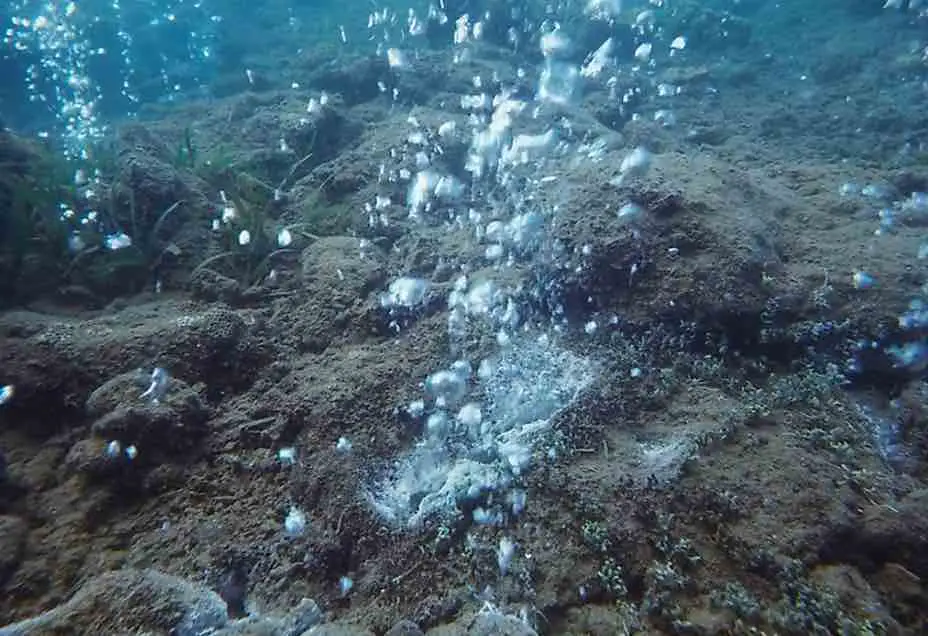
[In this paradigm] A bubbling cold seep.
Photo credit: WorldAtlas
What is a Heterotroph?
Heterotrophs are organisms that eat other plants or animals for energy and nutrients. The term came from the Greek words: "hetero" for "other" and "-troph" for nourishment. In an ecosystem, heterotrophs play the roles of consumers.
Examples of Heterotrophs
Heterotrophs include all animals and fungi, some bacteria and protists, and parasitic plants.
Heterotrophs occupy the second and third levels in a food concatenation. Herbivores – organisms that eat plants – occupy the 2d level. Carnivores (organisms that eat meat) and omnivores (organisms that consume both plants and meat) occupy the 3rd level.
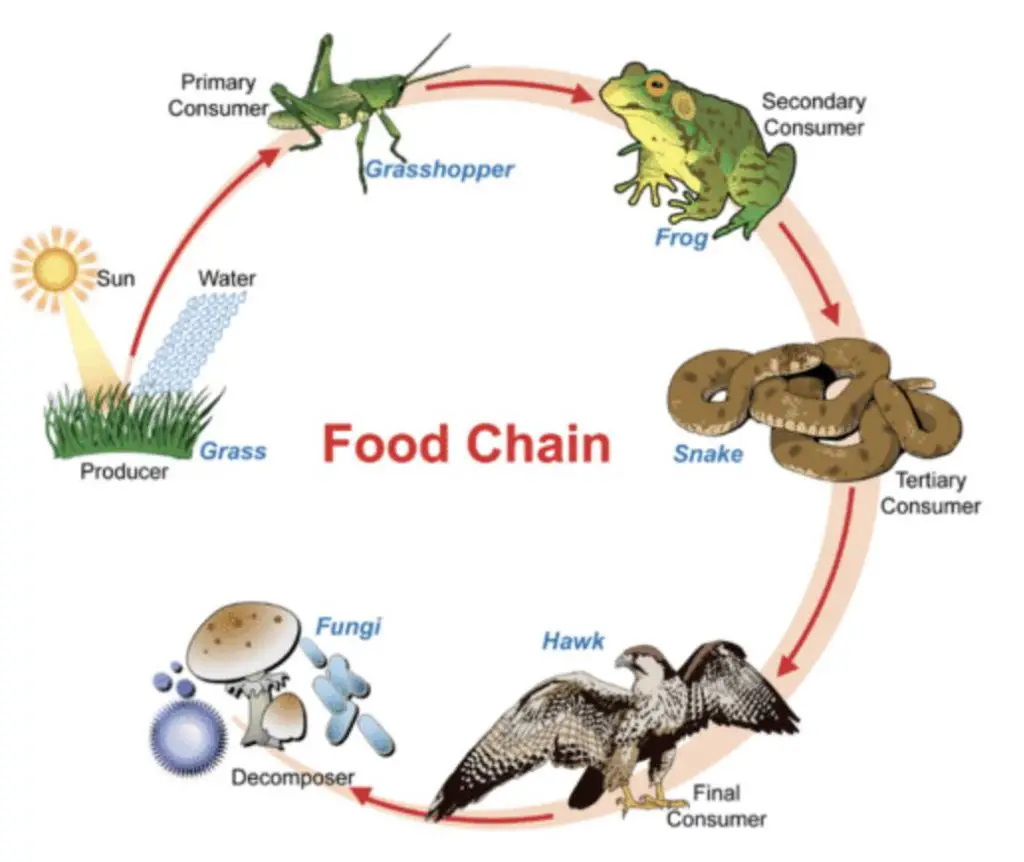
[In this image] A food concatenation shows how energy and thing flow from producers to consumers.
Photo credit: Biological science LibreTexts
Detritivores or decomposers are also heterotrophic consumers. These organisms obtain nutrient by feeding on the remains of plants and animals every bit well as fecal affair. Detritivores play an important function in maintaining a healthy ecosystem by recycling waste material. Examples of detritivores include fungi, worms, and insects.
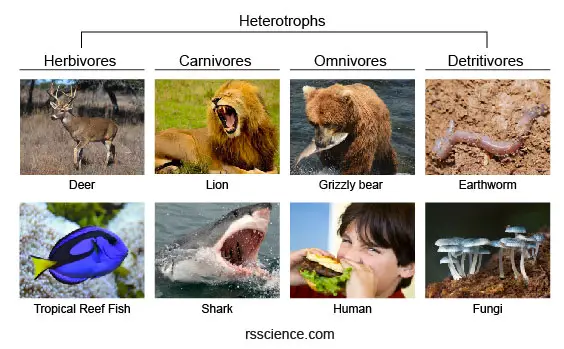
[In this prototype] Based on their relationship in a nutrient concatenation, heterotrophs can exist further classified as herbivores, carnivores, omnivores, and detritivores.
Mixotrophs – the gray area in-betwixt autotrophs and heterotrophs
Could an organism be autotrophs and heterotrophs at the aforementioned fourth dimension? Yes, many organisms possess the privilege to take more than than one energy source. Nosotros call them – mixotrophs.
Carnivorous and parasitic plants
Among plants, carnivorous plants, such every bit venus flytrap, tropical pitcher plants, and sundews, tin derive some nutrients from trapping and consuming insects. At the aforementioned time, they still keep the ability to generate energy from photosynthesis. Some semi-parasitic plants, similar mistletoe and clump, are also mixotrophs.

[In this image] Examples of cannibal plants.
Symbiotic relationships
Many protozoans tin live every bit mixotrophs by forming a symbiotic relationship with green algae. For example, symbiotic green algae can exist found in species of stentors, paramecia, and amoebas.
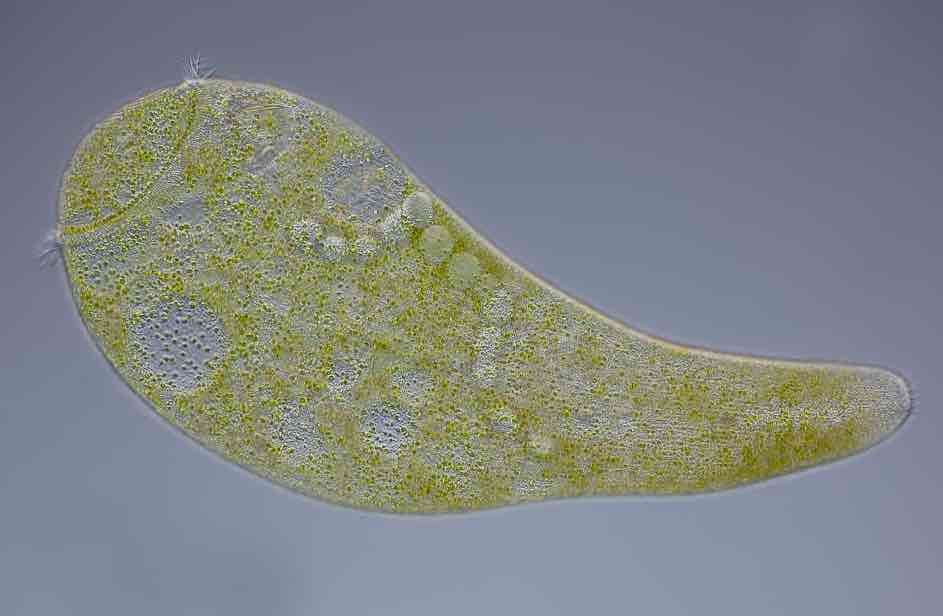
[In this image]Stentor polymorphus with algal symbionts (Chlorella) living within its trunk.
Stentor provides a rubber place for green algae. In return, green algae provide foods for Stentor. Green algae can also absorb and feed on the Stentor'southward metabolic wastes.
Photo credit: Mikro-Foto
Tin can animals live similar plants?
Mixotrophy is less common among animals. There are some examples living in coral reefs. Several members of cnidarians (due east.1000., coral, jellyfish, and ocean anemones) host endosymbiotic microalgae inside their cells, thus making them mixotrophs.
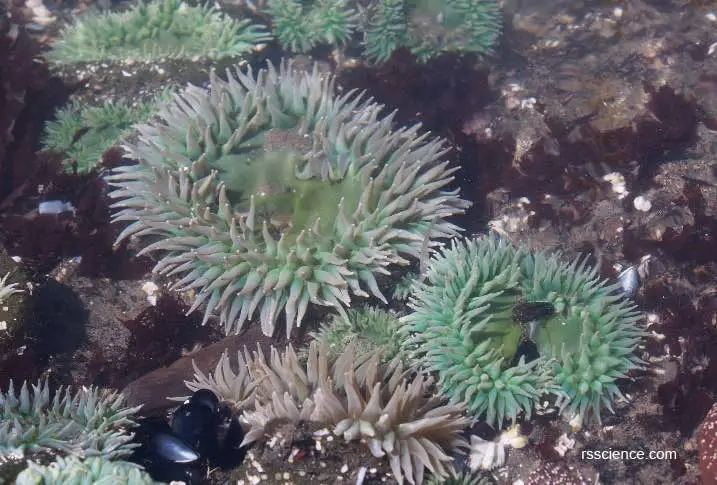
[In this image] These sea anemones accept cute dark-green color due to symbiotic algae living inside.
This symbiotic human relationship between algae and sea anemones is benign to both. The body of water anemones get oxygen and nutrients, whereas the algae get protection.
Elysia chlorotica (common name is the eastern emerald elysia) is ane of the "solar-powered sea slugs", utilizing solar energy like plants to generate energy. The sea slug eats and steals chloroplasts from the alga Vaucheria litorea. The sea slugs and then contain the chloroplasts into their ain digestive cells, where the chloroplasts continue to photosynthesize for upwards to nine months – that's even longer than they would perform in algae. The ocean slugs stay nourished thanks to the sugars produced by photosynthesis.
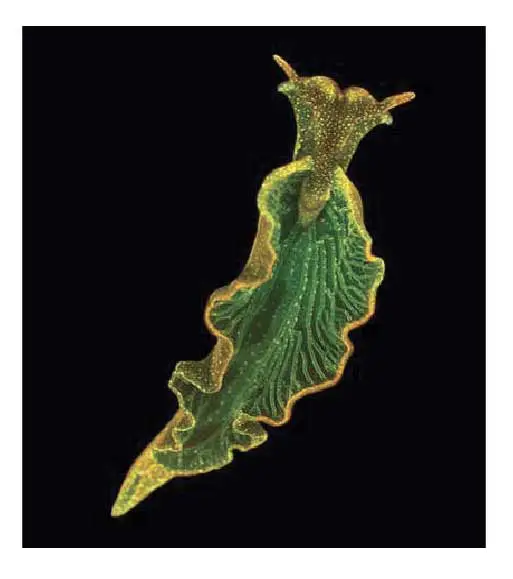
[In this image] Elysia chlorotica, a sea slug steals photosynthetic chloroplasts from algae.
Photo source: Mary S. Tyler/PNAS
Key takeaways
- Autotrophs tin can produce their own nutrients from inorganic materials through either photosynthesis or chemosynthesis.
- Heterotrophs do not produce their own food. They live past eating other organims to obtain the energy source.
References
"Algae, Phytoplankton and Chlorophyll"
Source: https://rsscience.com/autotrophs-vs-heterotrophs/
Posted by: archiemuchey.blogspot.com

0 Response to "Are Most Animal-like Protists Heterotrophs Or Autotrophs?"
Post a Comment